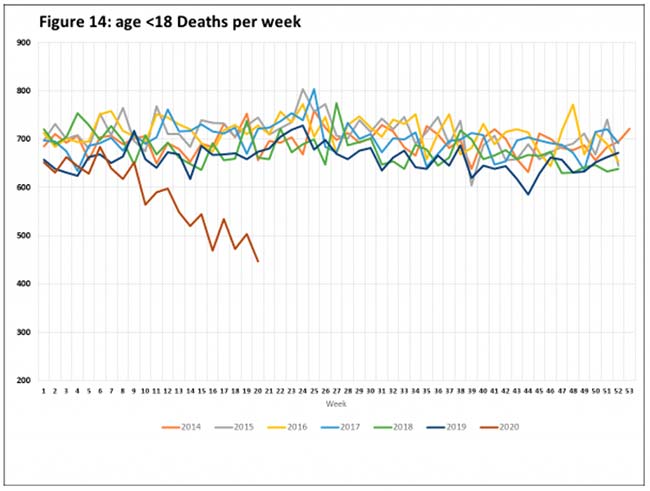SIDS and SADS – two sides of the same coin.
Tue 4:54 am +00:00, 14 Mar 2023In the same way sudden infant death syndrome did not exist until DPT vaccination … sudden adult death syndrome was not a thing until the COVID-19 vaccines came out …”
- In 2011, Neil Miller, Ph.D., and Gary Goldman, Ph.D., published a paper in the journal Human & Experimental Toxicology showing infant mortality rates correlated with childhood vaccination rates, with high-uptake countries having higher child mortality
- In January 2022, Goldman discussed the CDC’s suppression of undesirable vaccine data in an interview. In December that year, the Miller Lab at Brigham Young University in Utah, as part of the BYU Bioinformatics Capstone course, reanalyzed the Miller-Goldman paper in an effort to debunk it
- In response to the critique, Miller and Goldman conducted their own reanalysis, which was published in the peer-reviewed journal Cureus in early February 2023. The paper confirmed their 2011 conclusion that there’s a positive correlation between vaccine doses and infant mortality rates
- Data from the first few months of the pandemic seem to confirm this link, as the death rate for American children under 18 dropped during lockdowns, from an average of 700 per week to fewer than 500 per week during the months of April and May in 2020
- The decades-long work of Christine Stabell Benn, a clinical professor at University of Southern Denmark and her colleague Peter Aaby, a vaccine scientist, shows six of the 10 vaccines investigated increase infant mortality by rendering children more susceptible to other lethal diseases
Do childhood vaccines impact a child’s mortality risk? While controversy around this issue continues to swirl, peer-reviewed research suggests the answer is a yes.
In 2011, Neil Miller, Ph.D., and Gary Goldman, Ph.D., published a paper in the journal Human & Experimental Toxicology showing infant mortality rates correlated with childhood vaccination rates, with high-uptake countries having higher child mortality. As detailed in the abstract:1
“The U.S. childhood immunization schedule specifies 26 vaccine doses for infants aged less than 1 year — the most in the world — yet 33 nations have lower IMRs. Using linear regression, the immunization schedules of these 34 nations were examined and a correlation coefficient of r = 0.70 (p < 0.0001) was found between IMRs and the number of vaccine doses routinely given to infants.
Nations were also grouped into five different vaccine dose ranges: 12–14, 15–17, 18–20, 21–23, and 24–26. The mean IMRs of all nations within each group were then calculated.
Linear regression analysis of unweighted mean IMRs showed a high statistically significant correlation between increasing number of vaccine doses and increasing infant mortality rates, with r = 0.992 (p = 0.0009).
Using the Tukey-Kramer test, statistically significant differences in mean IMRs were found between nations giving 12–14 vaccine doses and those giving 21–23, and 24–26 doses. A closer inspection of correlations between vaccine doses, biochemical or synergistic toxicity, and IMRs is essential.”
Critiques of the Miller-Goldman Study
Through the years, the Miller-Goldman paper has often been cited as evidence that the U.S. childhood vaccination schedule may be doing more harm than good. And, aside from an early debunking attempt by Dr. David Gorski, a surgical oncologist, the paper has stood the test of time.
Gorski argued that Goldman and Miller had conflicts of interest that swayed their analysis — Miller, because he operates a website that promotes informed consent, and Goldman because he founded a medical journal that published papers that were critical of vaccines.2
“What Gorski failed to mention is that Goldman is an expert on the varicella virus and for eight years worked as an epidemiology analyst for the CDC in collaboration with the Los Angeles County Department of Health … to help conduct epidemiological studies of varicella disease at one of the three surveillance sites …
Goldman vaccinated his own children and supported vaccination at the population level during his tenure with the CDC. Goldman has also served as a professional peer-reviewer for numerous medical science journals …” Miller wrote in a rebuttal3 to Gorski’s review.
Goldman had initially joined the CDC thinking that it was the gold standard in unbiased research, but over the years, he realized that wasn’t the case. The CDC barred him from publishing any findings that linked the vaccination program with negative health outcomes, which led to his resignation in 2002, as he did not want to participate in research fraud.
He discussed the CDC’s suppression of undesirable vaccine data in a January 2022 interview.4 Then, all of a sudden, in December 2022, members of the Miller Lab at Brigham Young University in Utah, as part of the BYU Bioinformatics Capstone course, reanalyzed5 the Miller-Goldman paper and tried to debunk it yet again.
The critique, posted on the preprint server medRxiv (which is not peer-reviewed), claimed Miller and Goldman had employed “inappropriate data exclusions” to reach their conclusion, as they didn’t analyze the full dataset, which included 185 nations.
“We re-analyzed the original data used in Miller and Goldman’s study to investigate the relationship between vaccine doses and IMR,” the authors write.
“We show that the sub-sample of 30 countries used in the original paper was an unlikely random sample from the entire dataset, as the correlation coefficient of 0.49 reported in that study would only arise about 1 in 100,000 times from random sampling.
If we investigate only countries with high or very high development, human development index explains the variability in IMR, and vaccine dose number does not.
Next, we show IMR as a function of countries’ actual vaccination rates, rather than vaccination schedule, and show a strong negative correlation between vaccination rates and IMR … From our analyses, it is clear that vaccination does not predict higher IMR as previously reported.”
Critique Prompts Reanalysis
In response to the critique, Miller and Goldman conducted their own reanalysis, which was published in the peer-reviewed journal Cureus in early February 2023. The paper, “Reaffirming a Positive Correlation Between Number of Vaccine Doses and Infant Mortality Rates: A Response to Critics,”6 not only examines the critics’ claims and methods, but also includes additional analyses to assess the reliability of their original findings. As explained in the abstract:7
“The critics’ reanalysis combines 185 developed and Third World nations that have varying rates of vaccination and socioeconomic disparities. Despite the presence of inherent confounding variables, a small, statistically significant positive correlation of r = 0.16 (p < .03) is reported that corroborates the positive trend in our study.
Multiple linear regression analyses report high correlations between IMR and HDI, but the number of vaccine doses as an additional predictor is not statistically significant. This finding is a likely consequence of known misclassification errors in HDI.
Linear regression of IMR as a function of percentage vaccination rates reports statistically significant inverse correlations for 7 of 8 vaccines. However, several anomalies in the scatter plots of the data suggest that the chosen linear model is problematic.
Our odds ratio analysis conducted on the original dataset controlled for several variables. None of these variables lowered the correlation below 0.62, thus robustly confirming our findings.
Our sensitivity analysis reported statistically significant positive correlations between the number of vaccine doses and IMR when we expanded our original analysis from the top 30 to the 46 nations with the best IMRs. Additionally, a replication of our original study using updated 2019 data corroborated the trend we found in our first paper (r = 0.45, p = .002).
Conclusions: A positive correlation between the number of vaccine doses and IMRs is detectable in the most highly developed nations but attenuated in the background noise of nations with heterogeneous socioeconomic variables that contribute to high rates of infant mortality, such as malnutrition, poverty, and substandard health care.”

Download this Article Before it Disappears
Striking Decline in SIDS During COVID
In 2020, health authorities bemoaned the fact that COVID fears and lockdowns had the “unfortunate” side effect of lowering routine childhood vaccination rates. Vaccine safety advocates, on the other hand, predicted the decline might actually have a positive impact.
Childhood vaccines have long been suspected of being a contributing factor to sudden infant death syndrome (SIDS).8 As noted by Australian researcher Viera Scheibner, Ph.D.:9
“Vaccination is undoubtedly the single biggest and most preventable cause of cot-death … The timing of 80% of the cot [crib] deaths occurring between the second and sixth months is due to the cumulative effect of infections, timing of immunizations and some inherent specifics in the baby’s early development.“
Interestingly, data from the first few months of the pandemic seemed to confirm this link. According to a white paper10,11 by Amy Becker and Mark Blaxill, published June 18, 2020, the death rate among children under the age of 18 in the U.S. mysteriously dropped during the lockdowns, from an average of 700 per week to fewer than 500 per week during the months of April and May, as shown in the following graph.

While Becker and Blaxill12 admitted there were “no specific data on the SIDS trend during the pandemic,” the data did show that the drop was related to a dramatic reduction in infant death specifically, not older children or teens.
What’s more, according to researchers at the U.S. Centers for Disease Control and Prevention and Kaiser Permanente, the sharp decline in infant vaccinations began in early March 2020 — the same month that infant deaths started declining.13 Is that coincidence or a sign of causality?
Controlled Trials Are Needed
Becker’s and Blaxill’s findings were addressed in a June 16, 2020, BMJ commentary. Responding to the authors of a paper titled “Fewer American Infants Are Dying During the COVID-19 Lockdown. Why?” retired pediatrician Allan S. Cunningham wrote:14
“During the first 11 weeks of 2020 (through March 14) there were 209 fewer deaths in U.S. children <18 compared to the same period in 2019 (7024 vs 7233).
During the 11-week period following the emergency declaration (through May 30) there were 1465 fewer deaths in US children compared to 2019 (5923 vs 7388).15 The difference is statistically highly significant …
Becker and Blaxill emphasized that the most pronounced mortality decline occurred in infants <1 year. This is confirmed by reviewing the most recent data.16 There was a substantial and highly significant decline from 2020 weeks 5 through 11 to weeks 12 through 22 (367 to 309 infant deaths per week) …
The suggestion that vaccinations could be one factor in the causation of SIDS is not new … until properly controlled trials are done we will be unable to confirm or exclude a causal role for vaccines.”
Infant Vaccinations May Be Driving SIDS Rates
Some of strongest evidence linking SIDS and infant vaccines comes from Japan.17,18 Between 1970 and 1974, the Japanese compensation system paid out claims for 57 permanent vaccine injury cases related to the diphtheria, tetanus and pertussis (DTP) vaccine, and 37 deaths.
The cluster triggered a boycott of the vaccine by doctors in one of the prefectures. As a result of that boycott, the Japanese government raised the minimum age for DTP vaccination from 3 months to 2 years.19
In the six years that followed (1975 through 1980), Japan became known for having the lowest infant death rate in the world, and there were only eight severe reactions and three deaths following the DTP vaccine — an 85% and 90% reduction in severe injuries and deaths respectively.20
In contrast, the U.S. has the highest infant mortality rate — and the highest vaccination rate as well. If infant vaccinations improve health and save lives, why do statistics not support such claims? As noted in Miller’s and Goldman’s 2011 paper:21
“Prior to contemporary vaccination programs, ‘Crib death’ was so infrequent that it was not mentioned in infant mortality statistics. In the United States, national immunization campaigns were initiated in the 1960s …
For the first time in history, most US infants were required to receive several doses of DTP, polio, measles, mumps, and rubella vaccines. Shortly thereafter, in 1969, medical certifiers presented a new medical term — sudden infant death syndrome …
There is some evidence that a subset of infants may be more susceptible to SIDS shortly after being vaccinated. For example, Torch found that two-thirds of babies who had died from SIDS had been vaccinated against DTP … prior to death.
Of these, 6.5% died within 12 hours of vaccination; 13% within 24 hours; 26% within 3 days; and 37%, 61%, and 70% within 1, 2, and 3 weeks, respectively …”
SIDS and SADS — Two Sides of the Same Coin?
In the August 2022 Substack article “The Century of Evidence That Vaccines Cause Infant Deaths,” a doctor who goes by the moniker A Midwestern Doctor reviewed the link between vaccination and SIDS:22
“As best as I can tell from all the data that has been collected, is that the vaccines (especially TDP) cause microstrokes in the brain in the region that controls automatic respiration, so infants start having interrupted breath cycles, and unless they are at an ICU or somewhere else where they are monitored and can be resuscitated, once the breathing stops it is fatal …
In essence, this is identical to what has been observed with the COVID-19 vaccines — the reason the public’s attention has been drawn to this issue is because everyone can see the large number of sudden deaths they are causing even though many other side effects from the vaccines are much more common.
Similarly, much in the same way sudden infant death syndrome did not exist until DPT vaccination … sudden adult death syndrome was not a thing until the COVID-19 vaccines came out …”
Six of 10 Vaccines Investigated Found to Increase Mortality
Other compelling evidence linking vaccines and infant mortality comes from the decades-long work of Dr. Christine Stabell Benn, a clinical professor at University of Southern Denmark and her colleague Dr. Peter Aaby, a vaccine scientist and promoter of vaccination commissioned by the WHO to study the effects of vaccines used in charitable programs.
A review of their four decades of investigation was published in Clinical Microbiology and Infections in August 2019,23 and reported by Science News DK in December that year.24
Benn and Aaby also published a study25 in 2017, which showed the DTP program in Africa was a disaster, as vaccination was associated with a fivefold higher mortality, on average, than being unvaccinated — 3.93 times higher for boys and 9.98 times higher for girls.
In summary, Benn and Aaby, having studied the effects of 10 different vaccines on overall mortality, came to the shocking conclusion that six of the 10 increase mortality by rendering children more susceptible to other lethal diseases.
Overall, inactivated (non-live) vaccines increased mortality, especially among girls, even when they offered a high degree of protection against the target disease. This was true for the DTP, pentavalent vaccine, inactivated polio vaccine, H1N1 influenza vaccine and the hepatitis B vaccine.
GlaxoSmithKline’s antimalarial vaccine (RTS, S/AS01 or RTS,S, sold under the brand name Mosquirix), which appears to offer between 18% and 36.3% protection against malaria depending on the age group,26 was also found to increase overall mortality, in this case by a whopping 24%. As Stabell Benn told Science News DK:27
“A vaccine that protects against malaria that does not reduce mortality makes no sense. We therefore asked GlaxoSmithKline for access to the original data and found that the vaccine reduced mortality among boys by a modest 15% while doubling the overall mortality rate for girls. This was the sixth non-live vaccine that we associated with mortality among girls — exactly as we had seen for other non-live vaccines.”
Live attenuated vaccines, on the other hand — such as the older measles vaccine, the bacillus Calmette-Guerin against tuberculosis, oral polio vaccine and the smallpox vaccine — seemed to offer nonspecific protection against deadly diseases, contributing to a lowering of overall mortality.
Hexavalent Vaccines and SIDS
That simultaneous administration of multiple vaccines might be particularly risky seems obvious, yet it’s routinely done. A Midwestern Doctor writes:28
“Existing data suggests multiple vaccines being given simultaneously (e.g. through vaccines that combine multiple immunizations into a single shot), particularly the hexavalent vaccines (DTP + Polio + Haemophilus Influenza B + Hepatitis B) correlate with an increased incidence of SIDS. The following three studies support that link:
1. After GSK’s hexavalent vaccine was made available it Europe in 2000, a number of reports of infant deaths immediately following administration of that vaccine emerged.
This prompted a 2005 study29 of Germany’s adverse event database that analyzed the risk of sudden unexpected death in young children within 1 to 28 days after receiving a hexavalent vaccine. The study found … that in the second year of life, children were significantly more likely to die within 1 day … or 2 days … after hexavalent vaccination.
2. A follow-up30 to the German study using Italy’s national database of death certificates found that administering a hexavalent vaccine to infants of 1-24 months of age increased their risk of death in the 14 days after vaccination by 2.2 times …
3. On account of the data suggesting a link between hexavalent vaccines and SIDS, in 2011, an Italian judge ordered the release of GlaxoSmithKline’s confidential safety monitoring data within Italy.
Although GSK’s report stated less deaths than would naturally be expected occurred following vaccination (which suggests fraud as none of the vaccinated diseases cause sudden death …) GSK’s database also showed that approximately 90% of the reported infant deaths occurred immediately following vaccination.
A later confidential report by GSK was submitted to European regulators in 2015. Of the vaccine linked deaths that were reported within, 52.5 % clustered within 3 days post-vaccination and 82.2 % occurred within 7 days post-vaccination, and 97.9 % of all sudden deaths following the first dose of hexavalent vaccination … occurred in the first 10 days post-vaccination while just 2.1 % occurred in the next 10 days.
GSK’s reports once again substantiate the link countless others have found that SIDS disproportionately occurs immediately after vaccination.
If by some quirk of fate those suspect vaccines had coincidentally been administered at the same time SIDS would have occurred naturally (which is what debunkers have the audacity to argue), the timing that is consistently found for SIDS would not occur and the cases of death would be evenly spaced out over the entire 2-6 month period rather than being clustered to immediately follow vaccination.”
An analysis31 of data in the Vaccine Adverse Events Reporting System (VAERS) by Miller, published in 2021, also found that “Of 2,605 infant deaths reported to VAERS from 1990 through 2019, 58 % clustered within three days post-vaccination and 78.3 % occurred within seven days post-vaccination, confirming that infant deaths tend to occur in temporal proximity to vaccine administration.”
Transparency Is the Answer
As noted by Steve Kirsch, until or unless we have full data transparency, the question of whether the harm done by vaccines outweighs the benefits cannot be settled:32
“Is it possible that the more vaccines, the more deaths? That’s what the data says. Isn’t it time we stop hiding the record-level data on mortality and vaccines for the COVID vaccines and release it publicly?
The CDC is keeping these vaccine-death records under wraps because they don’t want to create vaccine hesitancy. It makes sense; when everyone finds out that they were duped they are going to be pissed. But sooner or later, one country is going to release the data and the cat will be out of the bag.
Any state in the US could publicly release their vax/death records. It could even be released in any county as well. Why is every county, state, and world government HIDING this data? … It’s public information. It doesn’t benefit the public when it is kept under lock and key.
Release the data! What is everyone afraid of? The truth? Note that the ‘privacy’ excuse is just that; an excuse. I point out that the data can be easily adjusted so that nobody can find even their own record without affecting any analysis.”













